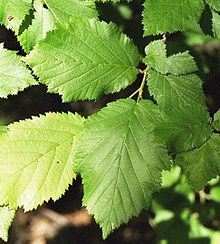- Corylus cornuta
-
Corylus cornuta' 
Beaked Hazel foliage Scientific classification Kingdom: Plantae (unranked): Angiosperms (unranked): Eudicots (unranked): Rosids Order: Fagales Family: Betulaceae Genus: Corylus Species: C. cornuta Binomial name Corylus cornuta
MarshallCorylus cornuta (Beaked Hazel) is a deciduous shrubby hazel found in most of North America, from southern Canada south to Georgia and California. It grows in dry woodlands and forest edges and can reach 4 – 8 m tall with stems 10 – 25 cm thick with smooth gray bark. The leaves are rounded oval, coarsely double-toothed, 5–11 cm long and 3 – 8 cm broad, with hairy undersides. The flowers are catkins that form in the fall and pollinate in the following spring.
Corylus cornuta is named from its fruit, which is a nut enclosed in a husk with a tubular extension 2 – 4 cm long that resembles a beak. Tiny filaments protrude from the husk and may stick into, and irritate, skin that contacts them. The spherical nuts, which are surrounded by a hard shell, are edible.
There are two varieties:
- Corylus cornuta var. cornuta - Eastern Beaked Hazel. Small shrub, to 4 m tall; 'beak' longer, 3 cm or more.
- Corylus cornuta var. californica - Western Beaked Hazel or California Hazelnut. Large shrub, to 8 m tall; 'beak' shorter, usually less than 3 cm.
External Links
PLANTS Database (Plants.usda.gov): Beaked Hazel with pictures
Categories:- Corylus
- Flora of Canada
- Flora of the Northwestern United States
- Flora of the North-Central United States
- Flora of the Northeastern United States
- Flora of the Southeastern United States
- Flora of Appalachia (United States)
- Flora of the Great Lakes region (North America)
- Flora of the Rocky Mountains
- Flora of California
- Flora of Colorado
- Flora of Alabama
- Flora of Michigan
- Trees of Canada
- Trees of the United States
- Edible nuts and seeds
- Garden plants of North America
- Ornamental trees
Wikimedia Foundation. 2010.



